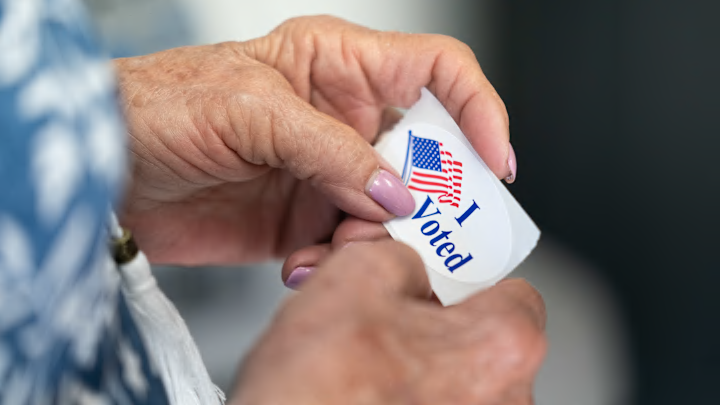The “I Voted” sticker, which you’ve no doubt seen attached to hundreds of shirts around the country and on social media during election season, has become a way for a person to demonstrate evidence of having done their civic duty—and a not-so-subtle prompt to encourage others to do the same.
It’s a simple, concise message. But the origins of this practice, as well as the person or persons who innovated it, aren’t quite so clear.
One of the earliest mentions of the “I Voted” sticker appeared in the October 27, 1950 edition of the Miami Herald, which made note of a movement to encourage businesses to give time off to employees so that they could vote on a bond issue for a $6 million local hospital expansion. The article went on to report that “I Have Voted” stickers would be handed out at the polls “as a reminder to others to cast their vote.” Reports of stickers being handed out in regional areas were prevalent throughout the 1950s, 1960s, and 1970s.
According to TIME, the Miami Herald was the source of yet another early mention of the “I Voted” sticker when, in 1982, the paper noted that businesses in Fort Lauderdale, Florida, were offering discounts to customers sporting the label. They were also distributed to teachers unions in 1984. That same year, incumbent Vice President George H.W. Bush flaunted an “I Voted Today—Have You?” sticker in Houston when he voted in the presidential election.
Who Really Popularized Those “I Voted” Stickers?
In 1985, the Phoenix Board of Realtors (now the Phoenix Association of Realtors) organized the distribution of the stickers in Phoenix and Maricopa counties in Arizona in 1985. Why did Realtors care? In Phoenix, a bond issue on the ballot would have allowed for expansion of the freeway system, which would have a positive effect on area property values.
The board’s then-president (and future Phoenix mayor) Skip Rimsza and operations director Dennis M. Burke created the sticker, which read “I Voted Today,” as a way of increasing voter activity. The hope was that people voting in the morning and wearing the sticker would urge others to vote during the remainder of the day.
The stickers became more prominent in 1986, when National Campaign Supply began selling them.
The most familiar version of the “I Voted” sticker, with a flag blowing in the wind, can be traced to Janet Boudreau, who created the design while working for another election-supply company, Intab, in 1987. That design was then copyrighted.
The stickers grew in popularity as a way to endorse voting and help return it to the public act it had been in the 19th century, where voting was practically a social gathering and ballots were handed off in full view of crowds. Today, showing off your political engagement costs local governments around 1 cent per sticker.
Discover More Fascinating Stories About Elections:
A version of this story was originally published in 2020 and has been updated for 2024.
